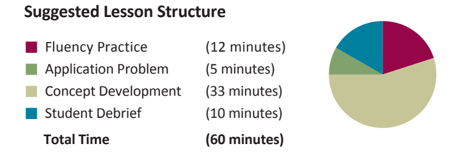Posted in: Aha! Blog > Great Minds Texas | Blog > Implementation Support > Maintaining Rigor with Eureka Math TEKS Edition®
What does rigorous mathematics mean to you? When answering this question, many teachers think of how difficult the math is for their students. But rigor and difficulty are not the same.
So, what is rigor? Rigor is about providing students with opportunities to explore and to forge a strong, authentic command of mathematical concepts. True rigor requires a high-quality curriculum and instruction that supports students’ exploration of math.
Balance conceptual learning, fluency, and application.
One way to think about rigor is as a balance of conceptual learning, fluency, and application. Eureka Math TEKS Edition has those components built right in. Still, when it comes to instruction, part of your job as a teacher is to maintain the balance. Emphasize each of the components with equal intensity. Equal intensity doesn’t mean allocating equal time or an equal number of problems for each component. It means using the components of rigor effectively and recognizing when each component is needed to help students deepen or extend their understanding of math. And these components aren’t mutually exclusive; they’re often in play simultaneously. For instance, the stated purpose of a particular activity may be to develop fluency, but it may also give students a stronger grasp of an underlying math concept. As you plan, think about how you can incorporate conceptual learning, fluency, and application. After a topic or module, reflect on how well you balanced the components of rigor. Make adjustments to achieve an even better balance with the next topic or module.
Use the components of rigor built into Eureka Math TEKS Edition.
In A Story of Units® (Grades K–5), the Eureka Math TEKS curriculum supports rigor by including in each lesson a section for Fluency, Concept Development, Application Problems, and a Student Debrief. While each lesson balances the components of rigor, that doesn’t necessarily mean it provides equal time for each component, as you can see in this lesson structure example from Grade 1 Module 2 Lesson 4. Each lesson distributes time differently among its sections.

In both A Story of Ratios® (Grades 6–8) and A Story of Functions® (Grades 9–12), Eureka Math provides four types of lessons that work together to create a rigorous curriculum. In the Teacher Edition, the type for each lesson is indicated with the following icons.
When you use Eureka Math as designed, you can be assured that the curriculum provides the necessary rigor. As you plan your lessons, consider how you’ll maintain or elevate the rigor for your students.When you use Eureka Math as designed, you can be assured that the curriculum provides the necessary rigor. As you plan your lessons, consider how you’ll maintain or elevate the rigor for your students.
Engage students with productive struggle to maintain rigor.
You care about your students, so it can be difficult to watch them struggle. But when the struggle is productive—when students engage in a math challenge within their reach but stretch their thinking—the struggle is good. It helps them extend and deepen their understanding of math. To maximize the benefits of the curriculum’s rigor, let your students experience productive struggle. That struggle leads to growth.
Stay rigorous and carry on!
Submit the Form to Print
.png)
Asma Akhras
Asma is an implementation leader for LAUSD with Great Minds. She has been in education for over 20 years.
Topics: Implementation Support



.png?width=111&height=100&name=TEXAS-Phd_LOGO_58C76Y_purple_tpt%20(13).png)

.png?width=73&name=image%20(3).png)

.jpg?width=430&name=PhD%20Science%20(1).jpg)





.jpg?width=430&name=EurekaMath%20(1).jpg)
.jpg?width=430&name=WitWisdom%20(1).jpg)

